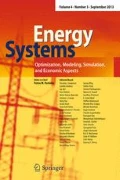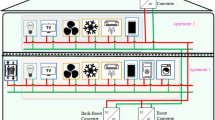Abstract
Most isolated microgrids are served by intermittent renewable resources, including a battery energy storage system (BESS). Energy storage systems (ESS) play an essential role in microgrid operations, by mitigating renewable variability, keeping the load balancing, and voltage and frequency within limits. These functionalities make BESS the central core of the microgrid operation, and means that BESS technology is expected to satisfy a series of requirements and specifications. At the same time, the applied technology restrictions must be taken into account by the control systems which makes the operation more complicated. There are several battery technologies that are available in the market. Traditionally, isolated microgrids have been served by deep discharge lead-acid batteries. However, Lithium-ion batteries have become competitive in the last few years and can achieve a better performance than lead-acid models. This paper aims to analyze both technologies by examining the operational requirements for isolated microgrids, by taking account of factors such as life cycle, logistics, maintenance, and initial investment. It includes a case study of an isolated microgrid with a lead-acid energy storage system at Ilha Grande, Brazil. Simulations led to significant conclusions regarding the particular features of both technologies that were compared during the operation and took note of the logistical constraints imposed by the location under consideration.





Similar content being viewed by others
References
Vargas, A., Saavedra, O.R., Samper, M.E., Rivera, S., Rodriguez, R.: Latin American energy markets: investment opportunities in nonconventional renewables. In: IEEE Power and Energy Magazine, vol. 14, no. 5, pp. 38-47, Sept.–Oct. 2016. https://doi.org/10.1109/MPE.2016.2573862
DNV GL, Quantitative risk analysis for battery energy storage sites, 2019. [Online]. https://www.dnvgl.com/publications/quantitative-risk-analysis-for-battery-energy-storage-sites-154811
Lighting Global, Lithium-ion batteries Part I: general overview and 2019 update, 2019. [Online]. http://lightingglobal.org/resource/Lithium-ion-batteries-update/
Nadeem, F., Hussain, S.M.S., Tiwari, P.K., Goswami, A.K., Ustun, T.S.: Comparative review of energy storage systems, their roles, and impacts on future power systems. IEEE Access 7, 4555–4585 (2019)
Baes, K., Kolk, M., Carlot, F., Merhaba, A., Ito, Y.: Future of batteries, 2018. [Online]. http://adlittle.com/en/insights/viewpoints/future-batteriesD
Barré, A., Deguilhem, B., Grolleau, S., Gérard, M., Suard, F., Riu, D.: A review on Lithium-ion battery ageing mechanisms and estimations for automotive applications. J. Power Sources 20, 680–689 (2013)
García-Vera, Y.E., Dufo-López, R., Bernal-Agustín, J.: Optimization of isolated hybrid microgrids with renewable energy based on different battery models and technologies. Energies 13(581), 1–17 (2020)
Xie, Z., et al.: Evaluation and analysis of battery technologies applied to grid-level energy storage systems based on rough set theory. Trans. Tianjin Univ. 20, 1–8 (2020)
Killer, M., Farrokhseresht, M., Paterakis, N.G.: Implementation of large-scale Lithium-ion battery energy storage systems within the EMEA region. Appl. Energy 260, 20 (2020)
Olabi, A.G., Onumaegbu, C., Wilberforce, T., Ramadan, M., Abdelkareem, M.A., Al-Alami, A.H.: Critical review of energy storage systems. Energy 214, 20 (2021)
Lighting Global, Lithium-ion batteries part II: safety (2019). [Online]. http://lightingglobal.org/resource/Lithium-ion-batteries-safety/
Groot, J., Swierczynski, M., Stan, A.I., Kær, S.K.: On the complex ageing characteristics of high-power LiFePO4/graphite battery cells cycled with high charge and discharge currents. J Power Sources 286, 475–487 (2015)
Stroe, D.-I., Swierczynski, M., Stan, A.-I., Teodorescu, R., Andreasen, S.J.: Accelerated lifetime testing methodology for lifetime estimation of lithium-ion batteries used in augmented wind power plants. IEEE Trans. Ind. Appl. 50(6), 4006–4017 (2014)
Swierczynski, M., Stroe, D.I., Stan, A.I., Teodorescue, R., Kær, S.K.: Lifetime estimation of the nanophosphate LiFePO4/C battery chemistry used in fully electric vehicles. IEEE Trans. Ind. Appl. 51(4), 3453–3461 (2015)
Beltran, H., Pérez, E., Ayuso, P.: Lifetime expectancy of lithium-ion batteries used for residential solar storage. Energies 2020, 1–18 (2020)
Cosme, D.L. S., et al.: Performance analysis and impact of the improvements added in ten-years of operation of microgrid of Lençóis Island. In: IECON 2019-45th Annual Conference of the IEEE Industrial Electronics Society, Lisbon, Portugal, 2019, pp. 2458–2463. https://doi.org/10.1109/IECON.2019.8927041
Microgrid, Stone Edge Farm., Definition, Microgrid: Online (2020)
Lockhart, E. , Li, X., Booth, S., Salasovich, J., Olis, D., Elsworth, J., & Lisell, L.: Comparative study of technoeconomic of Lithium-ion and lead-acid batteries in microgrids in sub-Saharan Africa, (NREL) (2019)
Kirubi, C. Jacobson, A., Kammen, D., Mills, A.: Community-based electric micro-grids can contribute to rural development: evidence from Kenya, World Development, pp. 1208–1221 (2009)
Zhang, F., Meng, C., Yang, Y., Sun, C., Ji, C., Chen, Y., Wei, W., Qiu, H., Yang, G.: Advantages and challenges of DC microgrid for commercial building: a case study from Xiamen University DC Microgrid, em: IEEE First International Conference on DC Microgrids (ICDCM), p. 2015. Atlanta, GA, USA (2015)
Energy, Nuvation: Solar-Powered Eco-resort. Consortium for Battery Innovation, London (2020)
Princeton Power Systems: Alcatraz Island Micro-grid. Princeton Power Systems, New Jersey (2015)
Microgrid Projects, Bonaire Microgrid, Microgrid Projects: Online (2020)
Neto, P.B.L., Saavedra, O.R., de Souza Ribeiro, L.A.: A dual-battery storage bank configuration for isolated microgrids based on renewable sources. IEEE Trans. Sustain. Energy 9(4), 1618–1626 (2018). https://doi.org/10.1109/TSTE.2018.2800689
Manjitha, L., Kumar, R.G., Kannan, S.: Lead acid based low voltage mild hybrid application in India—merits and challenges. In: IEEE Transportation Electrification Conference (ITEC) (2017)
Moseley, P.T., Garche, J.: Eletrochemical Energy Storage for Renewable Sources and Grid balancing. Elsevier, Amsterdam (2015)
Furukawa Battery, Lead-acid storage battery valve regulated lead-acid battery for cycle-use (2020) [Online]. https://corp.furukawadenchi.co.jp/en/products/indust/ub.html
Wang, J., et al.: Cycle-life model for graphite-LiFePO4 cells. J. Power Sources 196(8), 3942–3948 (2011)
Aneke, M., Wang, M.: Energy storage technologies and real life applications—a state of the art review. Appl. Energy 179, 350–377 (2016)
Mizumoto, I., Yoshii, Y., Yamamoto, K., Oguma, H.: Lead-acid storage battery recovery system using on-off constant current charge and short-large discharge pulses. Electron. Lett. 54(12), 777–779 (2018). https://doi.org/10.1049/el.2018.1079
Bindner, H., Cronin, T., Lundsager, P., Manwell, J.F., Abdulwahid, U., Baring-Gould, I.: Lifetime Modelling of Lead Acid Batteries, pp. 1–82. Riso-R Report, Denmark (2005)
Bashir, N., Sardar, H.S., Nasir, M., Hassan, N.U., Khan, H.A., Maximization, lifetime, of lead-acid batteries in small scale ups and distributed generation systems. In: IEEE Manchester PowerTech. Manchester, England, Vol. 2017, pp. 1–6 (2017). https://doi.org/10.1109/PTC.2017.7980993
Gaffar, M.A., Sabuj, M.E.H., Mostafa, F., Istiaque, T., Khan, M.F.: Simulink based performance analysis of lead acid batteries with the variation of load current and temperature. In: 4th International Conference on the Development in the in Renewable Energy Technology (ICDRET), Dhaka, Bangladesh, 2016, pp. 1–5. https://doi.org/10.1109/ICDRET.2016.7421472
Svoboda, V., Wenzl, H., Kaiser, R., Jossen, A., Baring-Gould, I., Manwell, J., Lundsager, P., Bindner, H., Cronin, T., Nørgard, P., Ruddell, A., Perujo, A., Douglas, K., Rodrigues, C., Joyce, A., Tselepis, S., Borg, N., Nieuwenhout, F., Wilmot, N., Mattera, F., Sauer, D.U.: Operating conditions of batteries in off-grid renewable energy systems. Solar Energy 81(11), 1409–1425 (2007). https://doi.org/10.1016/j.solener.2006.12.009
Wenzl, H., Baring-Gould, I., Kaiser, R., Liaw, B.Y., Lundsager, P., Manwell, J., Ruddell, A., Svoboda, V.: Life prediction of batteries for selecting the technically most suitable and cost effective battery. J. Power Sources 144(2), 373–384 (2005). https://doi.org/10.1016/j.jpowsour.2004.11.045
Dufo-López, R., Lujano-Rojas, J.M., Bernal-Agustín, J.L.: Comparison of different lead-acid battery lifetime prediction models for use in simulation of stand-alone photovoltaic systems. Appl. Energy 115, 242–253 (2014). https://doi.org/10.1016/j.apenergy.2013.11.021
Schiffer, J., Sauer, D.U., Bindner, H., Cronin, T., Lundsager, P., Kaiser, R.: Model prediction for ranking lead-acid batteries according to expected lifetime in renewable energy systems and autonomous power-supply systems. J. Power Sources 168(1), 66–78 (2007). https://doi.org/10.1016/j.jpowsour.2006.11.092
Cole, W., Frazier, A.W.: Cost projections for utility-scale battery storage, (NREL) (2019)
Santos Veras, L.D., Oliveira, H.A., de Matos, J.G., Saavedra, O.R., de Sousa Ribeiro, L.A., de Paula Assunção Pinheiro, L.: Analysis of performance and opportunity for improvements in the microgrid of Ilha Grande. In: IEEE 15th Brazilian Power Electronics Conference and 5th IEEE Southern Power Electronics Conference (COBEP/SPEC). Santos, Brazil, Vol. 2019, pp. 1–6 (2019). https://doi.org/10.1109/COBEP/SPEC44138.2019.9065856
Rubenbauer, H., Henninger, S.: Definitions and reference values for battery systems in electrical power grids. J. Energy Storage 12, 87–107 (2017)
Banco Central do Brasil, Focus-Relatório de Mercado, 15 Maio 2020. [Online]. https://www.bcb.gov.br/publicacoes/focus/15052020
Acknowledgements
The authors would like to thank the support of CPFL Energy, CNPq, FAPEMA and Equatorial Energy.
Author information
Authors and Affiliations
Corresponding author
Additional information
Publisher's Note
Springer Nature remains neutral with regard to jurisdictional claims in published maps and institutional affiliations.
Rights and permissions
About this article
Cite this article
Santos-Pereira, K., Pereira, J.D.F., Veras, L.S. et al. The requirements and constraints of storage technology in isolated microgrids: a comparative analysis of lithium-ion vs. lead-acid batteries. Energy Syst (2021). https://doi.org/10.1007/s12667-021-00439-7
Received:
Accepted:
Published:
DOI: https://doi.org/10.1007/s12667-021-00439-7




